Search results for: 'bronzezeit'
-
 Großes Skarabäussiegel aus der Zeit des Amenophis III.
Großes Skarabäussiegel aus der Zeit des Amenophis III.14. Jh. v. Chr. Heute noch erhaltene Überreste der Bautätigkeit Amenophis III. sind die Memnonkolosse, sowie der Hauptteil des Luxor-Tempels.
Price: on request Skarabäussiegel mit abstaktem Stempelmotiv
Skarabäussiegel mit abstaktem StempelmotivDie Stempelfläche trägt ein dekoratives Muster mit ästhetischer oder magischer Funktion. Sehr schöner und anschaulicher Skarabäus, in etwa aus der Zweiten Zwischenzeit des Alten Ägyptens. 2000 bis 1300 v. Chr.
Price: on request Ägyptisches Skarabäusamulett aus der 18. Dynastie
Ägyptisches Skarabäusamulett aus der 18. DynastieÄgyptisches Stempelsiegel-Amulett in der stilisierten Form eines Skarabäuskäfers. Die Stempelfläche trägt Hieroglyphen. Das Amulett datiert in die 18. Dynastie des Alten Ägyptens.
Price: on request Skarabäusamulett aus der Hyksoszeit
Skarabäusamulett aus der HyksoszeitÄgyptisches Skarabäusamulett mit typischen Symbolen für die Herrschaftszeit der Hyksos. Aus der Zeit der Fremdherrschaft, ca. 1650 bis 1550 v. Chr.
Price: on request Skaraboides Stempelsiegel
Skaraboides StempelsiegelÄgyptisches Stempelsiegel-Amulett in der stark stilisierten Form eines Skarabäuskäfers. Die Stempelfläche trägt eine symbolische Verzierung. 1. Jt. v. Chr.
Price: on request Ägyptisches Skarabäusamulett
Ägyptisches SkarabäusamulettSkarabäussiegel aus dem 2. Jt. v. Chr. mit ansprechender türkisfarbener Fayenceoberfläche. Die Stempelfläche trägt eine hieroglyphische Inschrift.
Price: on request Ägyptischer Skarabäus mit Knotenmuster
Ägyptischer Skarabäus mit Knotenmuster12. bis 18. Dynastie des Alten Ägypten, ca. 2000 v. Chr. bis 1300 v. Chr. Die Stempelfläche trägt ein Knotenmuster mit ästhetischer oder mutmaßlich magischer Funktion.
Price: on request Slender Egyptian stone beaker
Slender Egyptian stone beakerThe small and tall stone vessel is made of alabaster. From the collection of Egyptologist Professor Wiedemann.
Price: on request Egyptian chalice
Egyptian chaliceThe thin-walled stone cup is reminiscent of a lotus bud. From the collection of Egyptologist Professor Wiedemann. 18th dynasty of Ancient Egypt.
Price: on request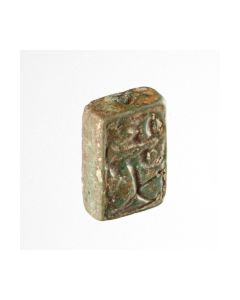 Ägyptisches Plättchen mit Kartusche des Sethos I.
Ägyptisches Plättchen mit Kartusche des Sethos I.Doppelseitige Platte aus grüner Fayence aus dem Neuen Reich, ramessidisch, um 1290 v. Chr. Sphinx und Kartusche (Men-Maat-Re) und Namens-Kartusche mit dem Eigennamen Meri-en-Ptah.
Price: on request Skarabäus mit Kartusche des Chaneferre
Skarabäus mit Kartusche des ChaneferreSkarabäus mit Namens-Kartusche des Königs Chaneferre (Sobekhotep IV.). 13. Dynastie des Alten Ägyptens, ca. 1700-1680 v. Chr.
Price: on request Scarab with sphinx
Scarab with sphinxThe stamp depicts a sphinx with pharaoh headcloth walking towards the Ankh symbol of life. The amulet should exert a protective function on the one carrying or owning it.
Price: on request Egyptian scarab with papyrus plants
Egyptian scarab with papyrus plantsScarab amulet made of bright, almost white steatite. 13th to 15th dynasty. This scarab is described in the catalogue of Irène Gautier-Vodoz.
Price: on request Egyptian faience ring showing Bes and Taweret
Egyptian faience ring showing Bes and TaweretThe finger ring with its scene on the plate must have served a protective function for an expectant mother. New Kingdom, approx. 1550 to 1070 BC.
Price: on request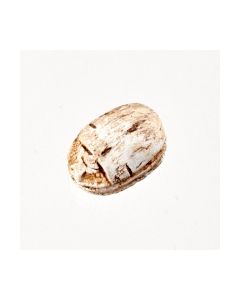 Scarab with lotus motive
Scarab with lotus motiveAncient Egyptian amulet seal with beautiful motive. Six lotus flowers are forming volutes. This scarab is described in the catalogue of Irène Gautier-Vodoz.
Price: on request Scarab with scarab motive
Scarab with scarab motiveThe stamp side shows a scarab with two uraeus snakes. This scarab is described in the catalogue of Irène Gautier-Vodoz.
Price: on request Egyptian fingerring from the Amarna period
Egyptian fingerring from the Amarna periodMade of colourful turquoise fayence. Two fully modelled crocodiles adorn the plate. Perfect preservation including original black paint.
Price: on request Ramesside Scarab
Ramesside ScarabEgyptian scarab from the 19th to 20th dynasty. With horse and hieroglyphs.
Price: on request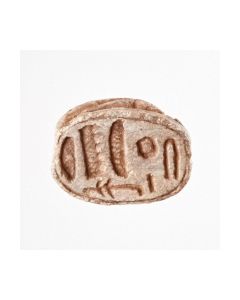 Scarab with inscription
Scarab with inscriptionThe lower side bears a hieroglyph inscription. Nice piece from the Freemark collection. New Kingdom.
Price: on request Scarab with cross symbol
Scarab with cross symbolA piece from the Ramesside Period to the early Third Intermediate Period of ancient Egypt. Great early 20th century provenance.
Price: on request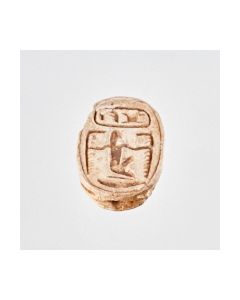 Scarab with god Heh and cartouche
Scarab with god Heh and cartoucheInteresting motive showing the kneeling god of endlessness with palm stem in both hands. Above him the cartouche of pharao Mencheperre. Around the 18th dynasty of ancient Egypt.
Price: on request Scarab with sphinx and Maat
Scarab with sphinx and MaatThe piece from the Ramesside period shows the goddess of truth and justice. Next to her is a name, probably that of pharao Mencheperre, who is famous as Thutmosis III.
Price: on request Scarab of pharao Seti I.
Scarab of pharao Seti I.The Egyptian scarab bears a hieroglyphic inscription which can be read as the name of pharao Seti I. From the Ramesside period, around 1300 BC.
Price: on request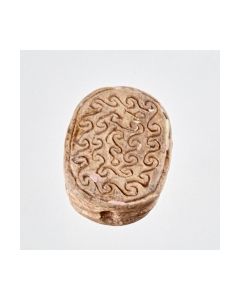 Scarab with spiral design and symbol for good luck
Scarab with spiral design and symbol for good luckThe Egyptian scarab from the Second Intermediate Period is decorated with a geometrical pattern. A nefer hieroglyph stands for good luck.
Price: on request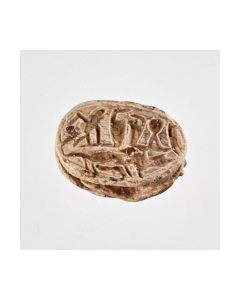 Scarab from the Ramesside period
Scarab from the Ramesside periodThe bottom side shows Horus, Uraeus and crocodile. The crocodile could be interpreted a the god Sobek.
Price: on request Egyptian Scarab
Egyptian ScarabThe scarab amulet is made of steatite. It has a hieroglyphic inscription on the lower side, including a reference to Amun-Re.
Price: on request Scarab with cartouche
Scarab with cartoucheThe scarab amulet has a cartouche and neb on the bottom. 18th to 20th dynasty of ancient Egypt.
Price: on request Scarab with twisted cord
Scarab with twisted cordScarab amulet with a twisted cord motive. Beautiful and well preserved piece from the Second Intermediate Period.
Price: on request Egyptian Scarab with sun beetle
Egyptian Scarab with sun beetleThe scarab amulet from Ramesside times has a beetle engraved in the lower side, flanked by two symbols.
Price: on request Scarab with magic spell
Scarab with magic spellThe hieroglyphs are of the so called anra design, a magic spell in the ancient Egyptian belief. The scarab is from the 13th to 15th dynasty. It is described in the catalogue of Gautier-Vodoz.
Price: on request Scarab with pattern of circles
Scarab with pattern of circlesThe beetle stone bears a popular motive of the Middle Empire. A nice example of its kind. This scarab is described in the catalogue of Irène Gautier-Vodoz.
Price: on request Scarab with geometric motive
Scarab with geometric motiveThe motive exhibits two symmetry axes and at least six triangles. A wonderful artistic expression of the highly evolved Egyptian maths. This scarab is described in the catalogue of Irène Gautier-Vodoz.
Price: on request Scarab with lion
Scarab with lionThe scene shows a walking lion. It is framed by an oval cord. This scarab is described in the catalogue of Irène Gautier-Vodoz.
Price: on request Scaraboid from the Middle Kingdom
Scaraboid from the Middle KingdomThe stamp shows hieroglyphs with a title for the king of Upper and Lower Egypt. This scaraboid is described in the catalogue of Irène Gautier-Vodoz.
Price: on request Cowroid with decorated body
Cowroid with decorated bodyThe cowroid has an interesting decoration across the upper surface. The lower surface is inscribed with hieroglyphs. This cowroid is discussed in the catalogue of Gautier-Vodoz.
Price: on request Pre-Dynastic pottery of Ancient Egypt
Pre-Dynastic pottery of Ancient EgyptThe simple vessel is made of coarse clay. It dates to the end of the 4th millenium BC and hence witnessed the beginning of the Ancient Egyptian civilization.
Price: on request

